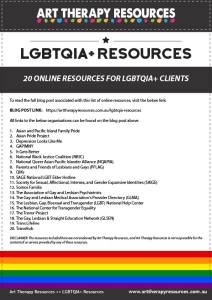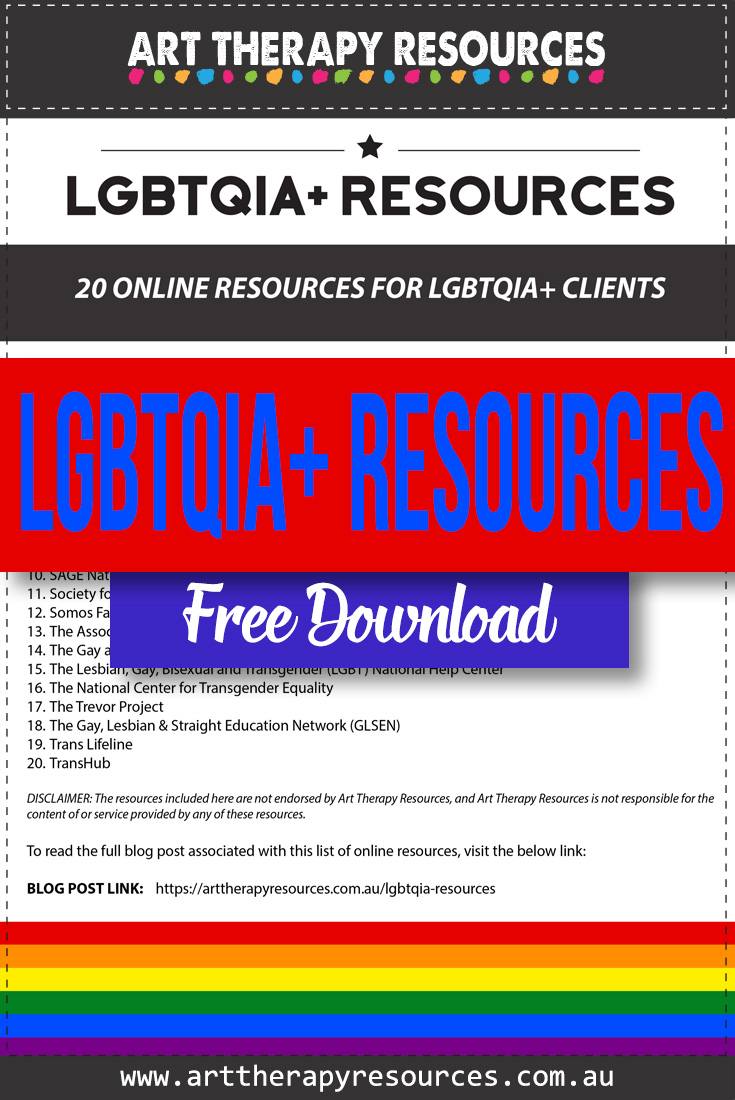THIS POST INCLUDES:
1. Mental health issues to consider
2. The Role of an art therapist
3. LGBTQIA+ Mental Health Resources
4. Free Download LGBTQIA+ Online Resources
MENTAL HEALTH ISSUES FOR LGBTQIA+ CLIENTS
Discrimination against LGBTQIA+ individuals can pose challenges to accessing and receiving adequate mental health care. Healthcare professionals may lack understanding of their unique needs, and negative experiences can deter individuals from seeking the help they require.
A significant rate of LGBTQIA+ youth have reported struggling with mental health which emphasizes the urgent need for psychological services tailored to the LGBTQIA+ community.
Fortunately, several mental health resources have been developed to address this need. These resources primarily help clients, however, they can also serve to help educate therapists working with clients.
LGBTQIA+ clients face mental health challenges like all people, however, they also experience other risk factors that may impact their mental health. These include:
- Coming out – this can be a difficult time for clients who feel they may face conflict with family, friends, and other peers about their core identity
- Rejection – people may experience rejection from family members, friends, and feelings of social exclusion
- Trauma – the LGBTQIA+ community experience significantly higher levels of bullying, homophobia, transphobia, and identity-based shame and trauma
- Substance abuse – for those who experience rejection and trauma based on their identity, substance abuse may be used as a coping mechanism
- Homelessness – family rejection may result in LGBTQIA+ youth and young adults becoming homeless
- Suicide – the LGBTQIA+ community experiences a higher rate of suicide due to the compounding issues they are faced with when embracing their core identity in a social structure that is not supportive
- Access to mental health resources – discrimination still exists within the mental health community which may limit access to mental health resources
THE ROLE OF AN ART THERAPIST
The American Art Therapy Association has also provided some guidelines for therapists to follow when working with clients.
These guidelines are summarised below:
- Be mindful of your understanding of LGBTQIA+ people and plan questions ahead of time.
- Help the client feel more welcome by creating an affirmative atmosphere.
- Ask culturally responsive questions.
- Focus on the client’s needs and what they expect and want from therapy.
- Never judge the client (this is especially so for their inner and outer presentations).
- There is a difference between assessment, assumption, and judgment.
- Manage your own emotions and countertransference related to clients’ gender and sexual identities —seek supervision, therapy, self-care, and informed trainings.
- Know that relationships take time.
- Refer to another art therapist or mental health professional when appropriate—it is okay to not be the expert every time.
- Keep yourself informed of the political actions that affect LGBTQIA+ individuals.
- Be aware of the safety resources for LGBTQIA+ clients such as 24/7 Trans Lifeline, 24/7 Trevor Project, and 24/7 National Suicide Prevention Lifeline.
Below is an outline of how an art therapist can help clients who identify as LGBTQIA+:
1. Create a Safe and Affirming Environment
– Establish trust with the client
– Use inclusive language
– Understand and respect the client’s identity
– Be aware of any biases or assumptions
2. Explore Identity and Self-Expression
– Use art-making as a way for the client to explore and express their identity
– Encourage self-exploration and self-expression
– Support the client in developing a positive sense of self
3. Address Trauma and Discrimination
– Help the client process any trauma related to their identity
– Address any discrimination the client may have experienced
– Provide a safe space for the client to express and process their emotions
4. Address Mental Health Concerns
– Address any mental health concerns the client may have, such as anxiety, depression, or trauma related experiences
– Use art-making as a way to help the client cope with their emotions and develop healthy coping skills
5. Foster Resilience and Empowerment
– Help the client build resilience and coping skills
– Empower the client to advocate for themselves and their community
– Encourage the client to use their art to promote social change and activism
6. Support Relationships and Community
– Address any challenges the client may have with relationships or community
– Encourage the client to build supportive relationships and connect with their community
– Use art-making as a way to foster connection and community-building
Overall, an art therapist can help clients who identify as LGBTQIA+ by providing a safe, supportive, and affirming environment for them to explore their identity, express their emotions, and build resilience. Through art-making, the therapist can help the client process trauma and discrimination, address mental health concerns, and foster empowerment and connection with their community.
LGBTQIA+ RESOURCES
- Asian and Pacific Island Family Pride
- Asian Pride Project
- Depression Looks Like Me
- GAPIMNY
- It Gets Better
- National Black Justice Coalition (NBJC)
- National Queer Asian Pacific Islander Alliance (NQAPIA)
- Parents and Friends of Lesbians and Gays (PFLAG)
- Qlife
- SAGE National LGBT Elder Hotline
- Society for Sexual, Affectional, Intersex, and Gender Expansive Identities (SAIGE)
- Somos Familia
- The Association of Gay and Lesbian Psychiatrists
- The Gay and Lesbian Medical Association’s Provider Directory (GLMA)
- The Lesbian, Gay, Bisexual and Transgender (LGBT) National Help Center
- The National Center for Transgender Equality
- The Trevor Project
- The Gay, Lesbian & Straight Education Network (GLSEN)
- Trans Lifeline
- TransHub
DISCLAIMER: The resources included here are not endorsed by Art Therapy Resources, and Art Therapy Resources is not responsible for the content of or service provided by any of these resources.
FREE DOWNLOAD
SIGN UP below to download the FREE list of 20 online resources for LGBTQIA+ clients.

BUILD YOUR ART THERAPY REFERENCE MATERIALS:
Pin this image to your Pinterest board.

SHARE KNOWLEDGE & PASS IT ON:
If you’ve enjoyed this post, please share it on Facebook, Twitter, Pinterest. Thank you!
